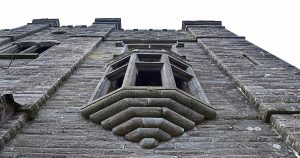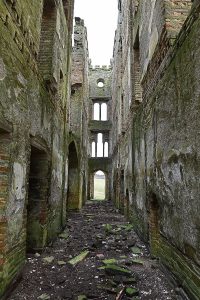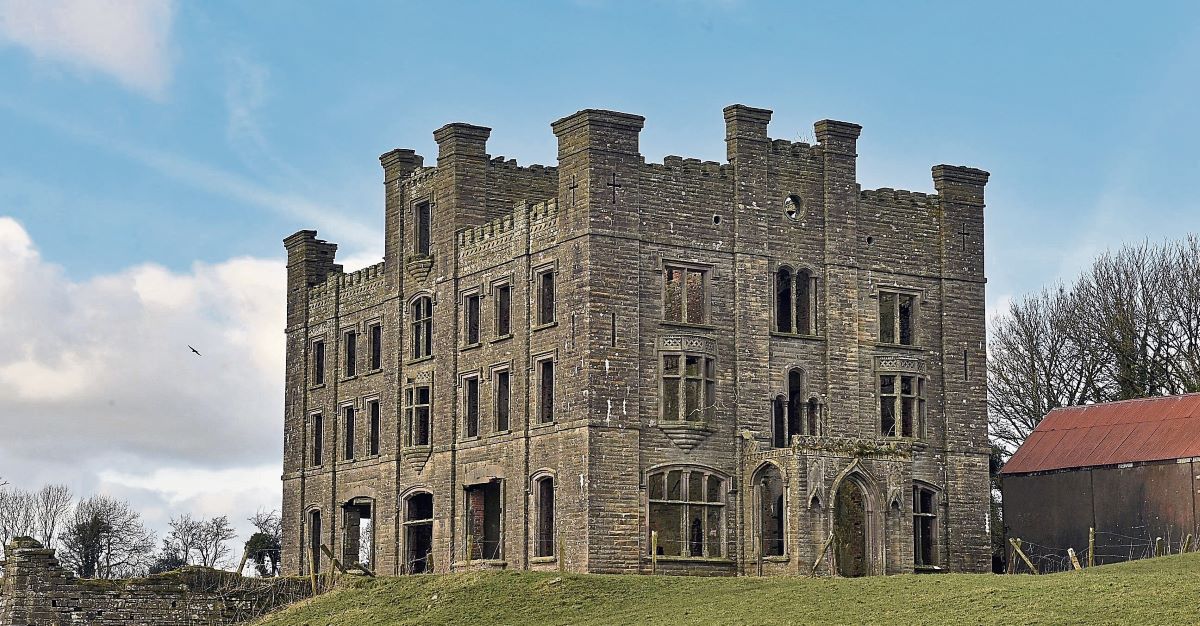Situated on the edge of Tyrone’s county lines is a formidable structure that has borne witness to both the grandeur of wealth and a poignant saga of love and loss.
The 170-year-old Ogilby’s Castle (also known as Altnacree, Altinaghree Castle or Liscloon House) is located between the towns of Dunamanagh and Ballyneaner.
The castle derives its name from the Ogilby family, who were heralded as the ‘wealthiest commoners’ in the North.
At the helm of this local legacy was William Ogilby, a scion of the family whose vision and ambition shaped the destiny of generations to come.
His journey into prominence began with his father’s investment in 3,170 acres of land at Terkernaghan and Altnachree in Donagheady, circa 1829.

However, this land remained untouched until William inherited it at some point before 1850.
By 1860, Ogilby’s Castle had been built, a symbol of William’s affluence and discerning taste.
Living lavish for his time, the castle was uniquely modern and eloquent in comparison to others built in the same period.
William requested the finest Irish cut stone to build the castle and the surrounding walls, seeking it horse-drawn all the way from Dungiven.
The finely-cut stone was set with particular attention to detail, with the front façade of the castle looking perfectly symmetrical to the eye.
The interior, resplendent with lavish furnishings and adorned with exquisite detail, reflected William’s penchant for luxury. A banquet room, rivaling those of the most esteemed establishments, played host to visiting dignitaries and luminaries from Dublin and London.
Before building his castle, William had distinguished himself in the realm of academia, a pursuit far removed from the linen trade that had defined his family’s fortunes.
During the 1830s, he gained reputation through his work at the Zoological Society in London, and in the following years of breakthrough identification and classification, he moved his way up to secretary of the society.
However, when news of the Irish famine came to him in London, he resigned as secretary and moved back home, telling his academic peers, “I am myself giving daily employment to 30-40 heads of families to keep them from actual starvation.”
Once he inherited his father’s land, William joined the Irish Relief Committee seeking a loan of £6,000 to reclaim parts of his land for agricultural purposes.
This reclaiming of land allowed him to employ 400 people daily to help save them from starvation.
In the later years of the famine, he built his castle near Dunamanagh and settled down, marrying the daughter of a local rector from Derry.
From here, William entered the life of a noble Irish squire: He became captain in the Royal Tyrone Militia in 1851, then served as High Sheriff of County Tyrone in 1852, a county magistrate by 1854, and was appointed a Deputy Lord Lieutenant in 1863.
He even purchased 2,900 acres of land in Omagh in 1853 for £30,000.
During the 1860s, he greatly expanded the site to include houses for the workers with more cut stone from Dungiven to develop a castellated look to the building, which for a brief time became an attractive entertainment destination for Irish high society.
William and his wife had two sons and five daughters, and although they had settled in his Dunamanagh castle, William took the decision to move to Dublin in 1872 for the betterment of his children’s education.
tumultuous affair
He left the castle to his youngest son James Douglas Ogilby, who became embroiled in a tumultuous affair that would forever alter the course of the family’s destiny.
Enamored by a working-class factory worker named Mary Jamison, James defied the conventions of his aristocratic upbringing, forsaking wealth and privilege in pursuit of true love.
He requested the permission to marry Mary, but parents rejected his marriage proposal because she was of a ‘lower class’ than the esteemed Ogilby legacy.
Their forbidden romance took an official pause for several years, although there were rumours of secret rendezvous and coded messages under the family radar.
William passed away in 1873 and in spite of his parent’s wishes, James went on to marry Mary Jamison in 1884 before setting sail to Australia with hopes of starting anew.
Despite forsaking his inheritance, James developed a great reputation for his work in studying reptiles, amphibians and fish species for the Australian Museum.
Back home, Claude Ogilby, James’ elder brother, inherited the castle, only to succumb to the pitfalls of excess and extravagance.
Neglecting the castle and becoming bankrupt due to his lifestyle, Claude fled in 1894 after the castle found itself in a ‘ruinous state’.
Claude spent his last days renting a room in a public house in Dunamanagh town before succumbing to kidney failure.
Today, this once elegant building is now in ruins… a skeletal relic of bygone glory.

A footnote to the story emerged approximately ten years ago when a descendant of the Ogilbys returned from Australia to find out about her Irish heritage. Joy Ware, an Australian author, visited the site of the family’s castle to research her book, ‘An Irish Castle, a Family and a Man with a Passion’.
Speaking at the time, she said, “I started looking into my family history because my aunt had a big folder of old family photos.
“I had known about the castle since I was a child, but it was never really talked about.
“I ended up with these drawings my great grandmother had done and when I realised they matched the photos of Altnachree I got very excited,” Joy said.
She concluded, “It has been a delight to be able to walk in the footsteps of my ancestors.”







